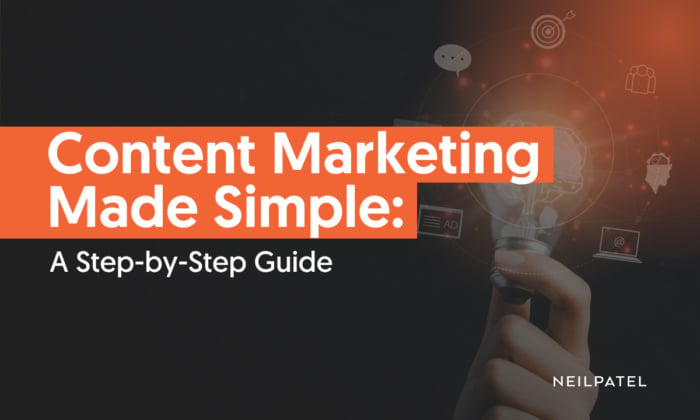
What is content marketing? Well, do you know who G.I. Joe is?
Yes, he is an action figure. But he is also one of the greatest examples of content marketing of all time.
That’s right. Content marketing isn’t just blogs, Twitter, Facebook, and YouTube. At its heart, content marketing is about storytelling—and humans have been telling stories for as long as they could speak.
So when Hasbro partnered with Marvel to launch their comic book series “G.I. Joe – A Real American Hero!” in 1982, their main marketing strategy was to create a rich backstory for their action figures.
And it worked wonders. Within two months of releasing the first comic book, about 20 percent of their target audience had two or more G.I. Joe toys. Fast forward seven years, the series was one of Marvel’s strongest titles, and two out of three boys between the ages of 5 and 12 owned at least one G.I. Joe action figure.
How’s that for using content to market a product?
A lot has changed since then, and what worked back in the ’80s won’t necessarily work today. However, with new marketing channels like social media popping up almost daily, opportunity is knocking.
Definition of Content Marketing
Are you looking for a content marketing definition? You’ll find many different answers to this question online, but here’s my take on what content marketing is:
Content marketing is a long-term strategy that focuses on building strong relationships with your target audience by consistently delivering high-quality, relevant content that educates and, ultimately, sells.
It is not a hard sell, though. Your content should generate so much value that when a prospective customer chooses to make a purchase, you are the first person they think of and the authority they trust most.
In contrast to one-off advertising, content marketing shows that you actually care about your customers. That is key to the strategy’s success. Today, more than ever before, people want to feel like they matter. The world is louder and noisier now, and retaining consumers’ attention and trust is a marketer’s most valuable resource.
Content marketing is also different from copywriting. Copywriting is focused on conversions primarily, while content marketing is focused on building an audience. It doesn’t have to be a case of copywriting vs. content marketing, though. You can use both to create content that educates and sells.
If you are new to the field and want some more baseline information, check out my beginner’s guide to content marketing. If you are looking for some more comprehensive insight, read on.
Why Is Content Marketing Important?
Now that we know what content marketing is, let’s explore its importance.
In many ways, content marketing is the complete customer acquisition channel. It drives traffic, builds trust, establishes your authority, and generates revenue.
Sure, pay-per-click (PPC) ads can bring traffic and revenue. Social media can be used to position your brand as an authority. But only content marketing helps you achieve a host of marketing goals without coming across as salesy in the first place.
Content marketing is so important—and works so well—because it captures people throughout the sales funnel.
You can use content marketing to attract users at the very top of the funnel, before they even think about making a purchase.
In many cases, a great piece of content is the moment when your relationship with the customer begins, and that content is going to be with them through every step of the customer journey.
That’s well and good, but it’s all for naught if those efforts don’t generate revenue. That’s not the case with content marketing, however. In fact, the yearly return on investment (ROI) for a successful content marketing campaign is $984,000.
This is why 82% of marketers are still actively investing in content marketing. And it’s why you should, too.
History of Content Marketing
How old would you guess that content marketing is?
When someone first asked me that question a few years ago, I thought it had been around for maybe 50, 70, or perhaps even 90 years.
But I was wrong. Completely wrong.
According to the Content Marketing Institute’s timeline, the very first occurrence of true content marketing appeared in 1732 in the form of Poor Richard’s Almanack created by Benjamin Franklin.
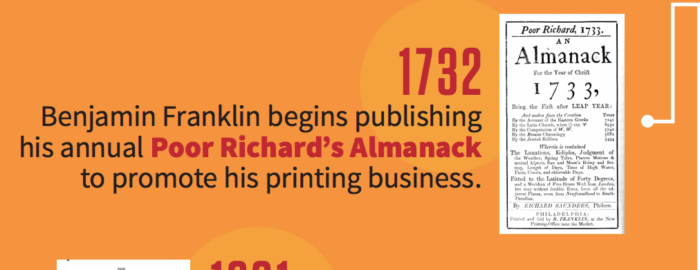
That was almost 300 years ago.
Since then, businesses and individuals alike have tried to garner attention by creating free or cheap content.
John Deere, the tractor company, did something similar to Franklin in 1895 when they produced a lifestyle magazine for farmers called “The Furrow.”
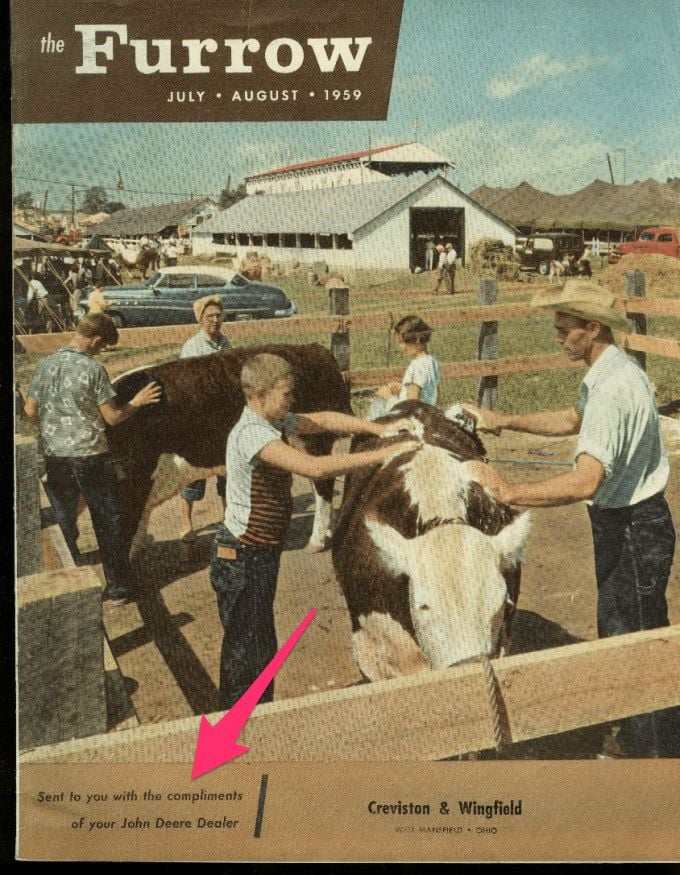
As you can see in the bottom left-hand corner, it was a complimentary magazine.
Now, you could argue that John Deere did this out of the kindness of their hearts. Perhaps they simply wanted to help people.
More than likely, though, John Deere did this because they understood the benefits of content marketing: If you produce free and helpful content for your target market, they engage with you, spread your message, and probably even buy from you.
Below is another example from Safari Cards that ran for almost 10 years starting in 1978.
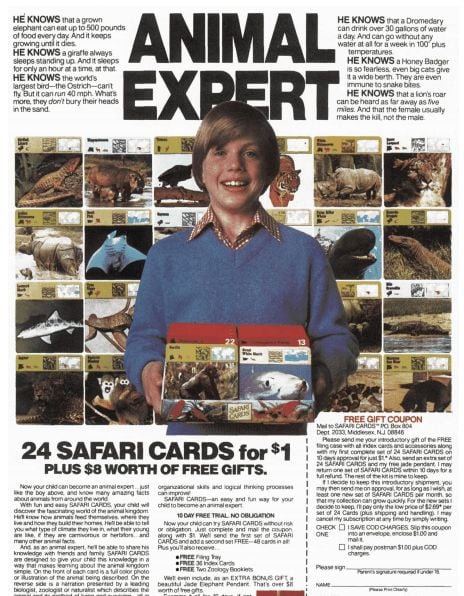
Now, of course, content marketing takes many different forms, including videos and infographics.
Even though the methods for content marketing have changed over the years, the formula for great content has stayed largely the same.
It’s the same formula for getting people to buy your products.
- Push on the person’s pain point.
- Agitate that pain.
- Solve their problem.
What Makes a Successful Content Marketing Strategy?
A successful content marketing strategy is not one that jumps on the latest content marketing trends. It is one that has a clear goal and a focused target audience.
You see, if your content doesn’t cater to the right people with the right problem (that your product solves), then it’s likely you’ll end up wasting your content marketing efforts.
Start outlining what you want to achieve with your content marketing efforts. It could be to raise brand awareness, acquire email addresses, or increase conversion rates.
Next, define exactly whom you want to target. For example, my content marketing efforts are targeted at marketers and entrepreneurs who have businesses that operate predominantly online and who want to learn more about increasing traffic to their websites and generating more online revenue.
Finally, write a clear plan about how you will achieve your goal.
If you want to increase email subscribers, for instance, your content plan may be to create an eBook, write a landing page for the eBook, and then create a series of blog posts and emails that drive traffic to that landing page. Your plan should highlight who will create each piece of content, when it will be written, and where it will be posted.
Content Marketing Types
As I’ve explained, content marketing doesn’t just take the form of blog posts. There are several offline, online, and hybrid content marketing types I’ll explore below.
Offline Content Marketing
Offline content marketing isn’t quite as popular as it was a century ago, but there are still plenty of great examples to take inspiration from.
Offline Example #1: Netflix’s Offline Experiences Boost Streaming Audiences
Netflix is the premier streaming service. It’s also a leader in offline content marketing.
To help spread the word about an upcoming series or film, Netflix often turns shows into interactive offline experiences around them. For instance, Netflix launched a series of billboards and murals for its hugely popular “Money Heist” show, along with experiences so people can become part of the “heist.”
Additionally, Netflix advertises its “original” shows to new audiences in outside locations and through ambient marketing; this involves placing adverts in unlikely but unobtrusive places and carefully placing outdoor banners.
Most importantly, Netflix’s offline advertising strategy is cohesive, working alongside its online content marketing, as part of a multi-channel approach.
Offline Example #2: Hasbro’s Commercial Turned TV Show
When Hasbro released the G.I. Joe comic book series, it faced a dilemma. The company wanted to run TV commercials to promote its action figures and comic books.
However, TV regulations stated toy commercials had to focus on the toys and could only include up to 10 seconds of animation so as not to mislead kids into thinking the toys could do more than they did.
Hasbro circumvented this problem by focusing on the story, not the product: It completely took out the toys and just promoted the comic book series. Never before had a TV commercial solely promoted comics, and, thanks to bending the rules, Hasbro could show 30 fully animated seconds of material.
The original commercial even made it to YouTube.
Online Content Marketing
OK, so offline translates to online one way or another, but hasn’t content marketing really been all about the interwebs from the beginning?
Yup, it has.
Brands are huge on it, and some do a pretty good job, and that’s why it’s time to look at some of the best examples of content marketing that originated online.
Online Example #1: Lead Magnets
Even if you’re relatively new to marketing, I’m sure you’re familiar with the term “lead magnet.” If you’re not, it basically means creating an irresistible piece of content your target market can’t wait to trade their email address for. It usually takes the form of an eBook, cheat sheet, or white paper.
Once brands have a user’s email address, they can send emails to nurture the relationship and, ultimately, turn that consumer into a buyer.
There are numerous examples of lead magnets I could cite here, but I’ll go with the online marketing tool WordStream.
The site offers dozens of free resources that help users overcome major pain points like getting the most out of Google Ads, finding better keywords, and increasing conversion rates. All users need to do is fill in a short form to download them.
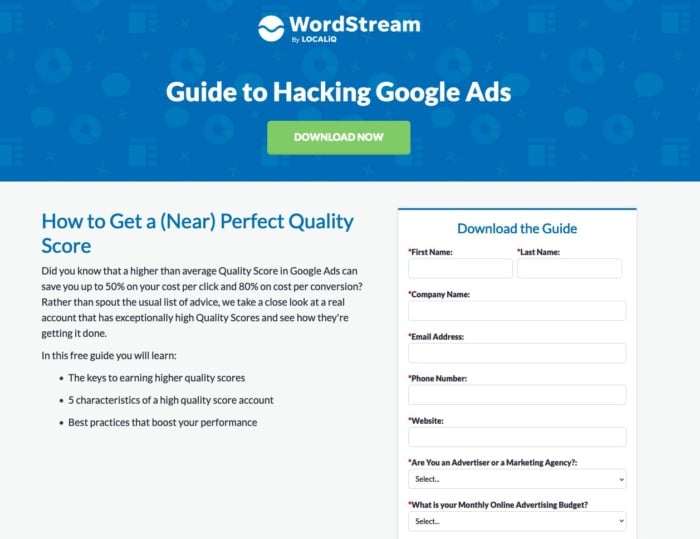
What WordStream does particularly well is integrating these lead magnets into blog posts. For instance, if I’m reading an article about subject lines, WordStream serves up an email-related gated asset at the end.
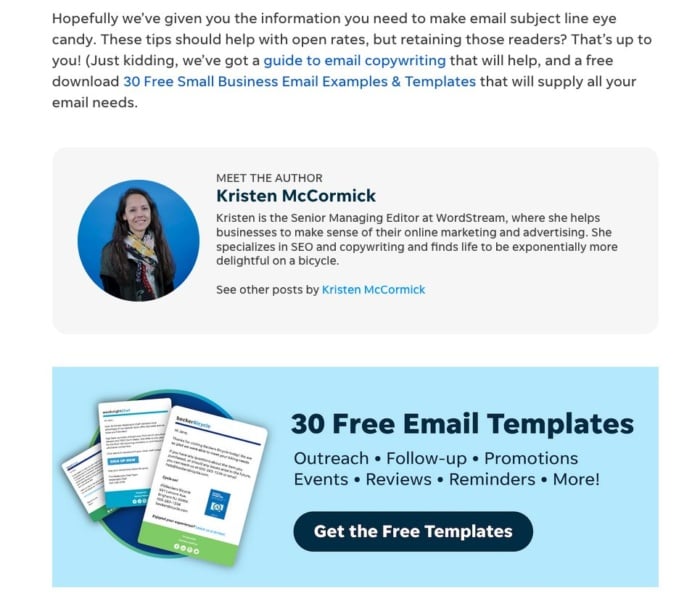
Online Example #2: Podcasts
Some people, like Tim Ferriss and Joe Rogan, have built entire businesses out of podcasting. But other brands use them as a fantastic form of content marketing that doesn’t require any actual writing at all.
Take Shopify Masters, for instance. Shopify doesn’t need a podcast to boost its bottom line, but it uses podcasting as a way to expose more people to its brand and encourage would-be entrepreneurs to build their own stores.
Each episode, hosts chat with a different e-commerce founder about their business, lessons learned, and resources that have helped them. It’s the perfect content for Shopify’s target market.
Online Example #3: Guides and eBooks
Free guides and eBooks are great ways to give customers a taste of your product offering before they buy. They are also fantastic at building authority and proving to would-be customers that you know your industry better than anyone else.
Customer support platform Intercom uses free guides better than anyone else I know. They have a free guide or ebook on just about every aspect of online customer service you can imagine.
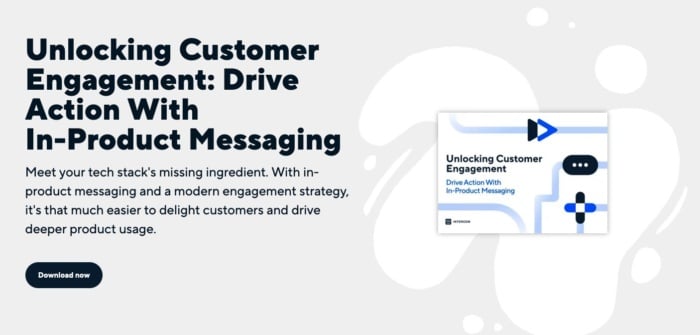
These aren’t short cheat sheets, however. These are seriously in-depth guides that weave together expert advice with the company’s product to create something that educates and sells. Just reading one is enough to prove that you can trust Intercom to help you improve online customer service.
Online Example #4: Video content
This one’s remarkable. It’s like Red Bull created its own mini version of the Super Bowl.
On October 14, 2012, Austrian skydiver Felix Baumgartner jumped out of a hot air balloon floating in the stratosphere. He basically jumped toward the Earth from space.
He fell down 24 miles at 843 mph. He broke Mach 1 and 3 while simultaneously breaking three world records: the first human to break Mach 1 without any engineered vehicle, world’s highest balloon travel, and highest jump.
Never has anyone done this before.
And who was the sole sponsor of the event? It was Red Bull.
They made history—and marketed it.
Not only did the event get insane media coverage and buckets of social media activity, but it also went into the Guinness Book of World Records for the first freefall to break the sound barrier.
It was full of excitement and gripping suspense. It was entertainment at its best. And needless to say, it was a total home run for Red Bull.
Online Example #5: Brand Collaborations
How does the old saying go? If you want to go fast, go alone. If you want to go far, go together.
Going further than anyone else is exactly what brand collaboration content marketing efforts are all about. Rather than build assets on your own, you can share the workload and double the value by partnering with a non-competitive brand in the same industry.
Not only do you create something more valuable than you could on your own, but you also get the chance to promote your brands to an established audience of potential customers.
Paid advertising agency KlientBoost is a proven practitioner of creating branded content marketing efforts. They’ve worked with some of the biggest brands in online marketing, including HubSpot, Instapage, and Ahrefs to create a range of useful resources.
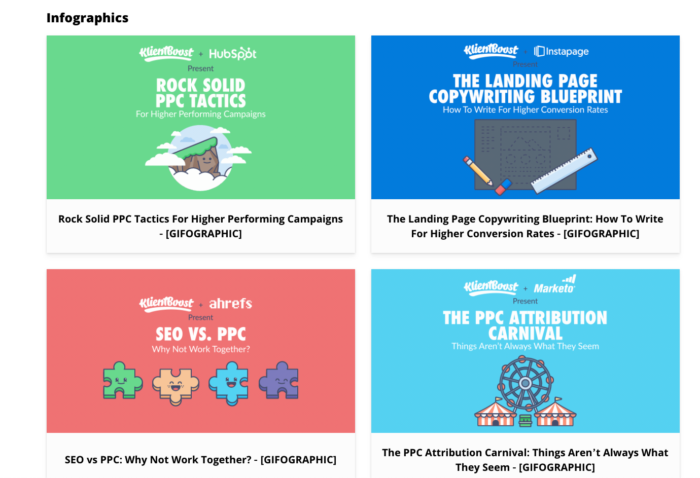
Content Marketing Hybrids</h3>
Finally, I want to show you an example of what I call hybrid content marketing. I already showed you that online translates to offline and vice versa. Well, some companies combine both online and offline content marketing in the same campaign.
Take Adobe’s MAX conference, for example. The conference itself is a fantastic piece of offline content marketing. But Adobe takes things a step further by uploading hundreds of sessions for free on their website, allowing anyone to watch them.
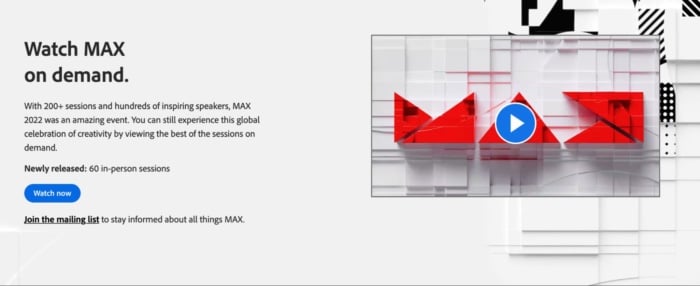
What a fantastic way of endearing your brand to thousands of potential customers and inspiring them to take action with your platform.
Content Mapping Based on the Customer Journey
Content mapping is the act of understanding your audience so well that you can then create content for each stage of their journey toward buying your product.
Few people go straight from discovery to buying. Instead, they usually discover your website and product, spend a few months thinking, see a retargeting ad, and then buy.
Or something similar to that.
What’s great about content marketing is that you can use it to target every stage of the customer journey: attracting, engaging, delighting, and gently nurturing them until they become a buyer, and hopefully, a loyal customer.
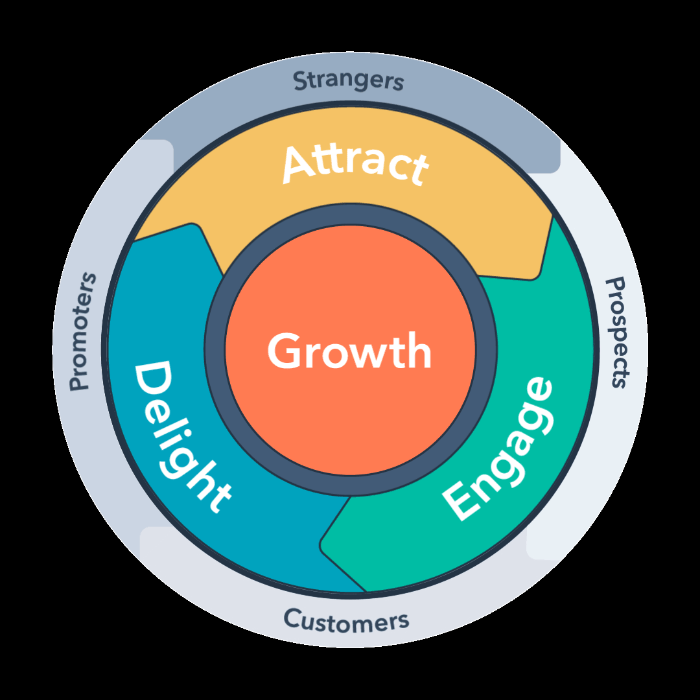
If you get it right, these loyal customers then become evangelists for your brand, spreading the word about your product/services among friends/family, social media, and other formats.
But you can’t use the same type of content for each state of the buyer journey. As I explain below, each stage requires a different kind of content marketing.
Awareness Stage for Content Marketing
The first stage of a buyer’s journey is awareness.
They aren’t necessarily ready to buy yet or even ready to opt in to your email list or newsletter. But that doesn’t mean you can’t offer value by creating content around broad topics and solving their problems.
Why is that valuable to your business? Because by creating content that solves people’s problems, you help them to discover and trust your brand. And then in the future, when they are ready to buy, you’ll be one of the first people they think of.
For example, I searched for “How to write a blog post” on Google. This is what came up.
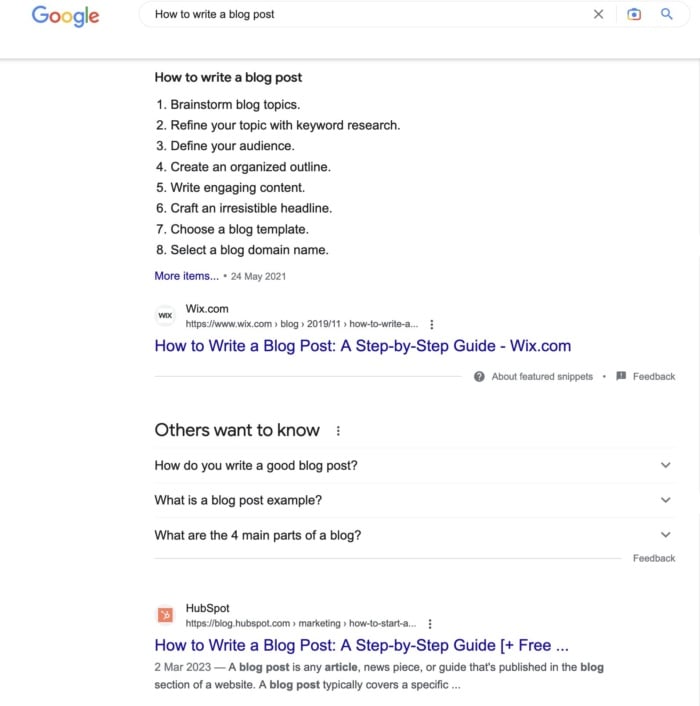
Which result would you click on? That’s right: the big Google snippet from Wix.
Alternatively, and forgive me for the self-promotion, but you might even click this post about how to write a blog post in under 60 minutes:
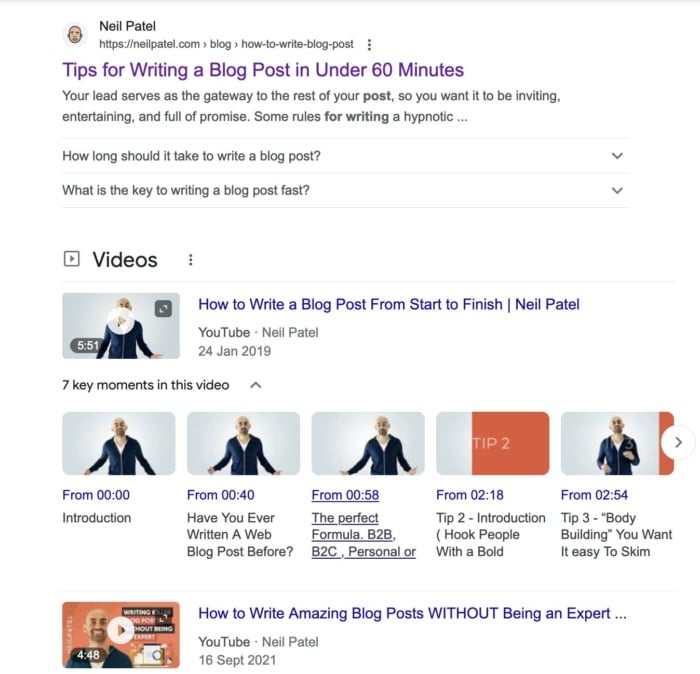
Or even watch one of my videos.
If you don’t know who Wix and my brand are or what we do, you soon will. This shows you how powerful content marketing and SEO together can be for building brand awareness.
If you want to be successful at creating content for the awareness stage of the buyer’s journey, then pay attention to the most important content marketing metrics. These include measuring:
- Users, page views, and unique views to understand brand awareness
- Click-through rates, bounce rates, social shares, comments, social mentions, time on site, and inbound links, to analyze engagement
- Page and domain authority for SEO
- Click-through rates and conversions, to see conversions
- Demo requests, sales conversion rate, and sales cycle length, for understanding sales enablement metrics.
Blog content isn’t the only medium you can use for top-of-funnel content marketing.
Social media content is another great way to build brand awareness.
Since most people access their accounts every day or every week, the chances of people seeing your posts skyrocket. That’s true even if you only post three or four times a week.
It’s exactly why massive retail brands like Dove use the platform to spread brand awareness and engage their audience.
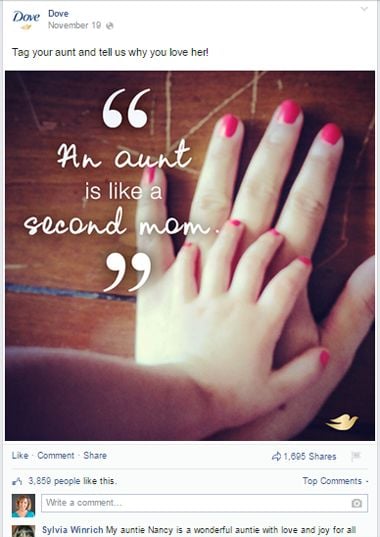
Just remember that people don’t go onto social media platforms because they want to see your posts and buy your products (unless we’re talking about Pinterest).
For that reason, don’t be too salesy.
Ideally, you want to spread your brand message and strengthen your brand identity by being helpful and entertaining.
Consideration Stage for Content Marketing
Consumers don’t buy from brands the moment they learn about them. It can take weeks, months, or even years for consumers to move through the consideration stage of the buyer’s journey.
The good news is you can speed this up with content marketing.
Ask any great salesperson and they’ll tell you this: People are far more likely to buy when you guide them through the process.
However, you can’t, or rather shouldn’t, use the same brand awareness tactics during the consideration phase.
In particular, pay special attention to newsletter sign-ups, number of returning visitors, form submissions, and resource downloads.
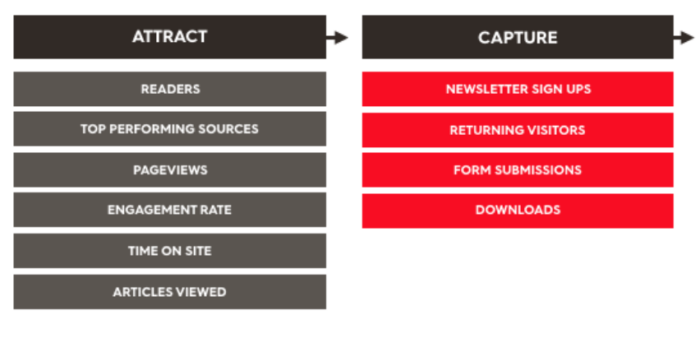
Basically, you’re trying to gauge the interest of your current prospects.
To do that, though, you first must create content to continue attracting people who are interested in your products.
Content like eBooks, for instance, does a remarkable job of building trust during the consideration phase. Why does an eBook do such a fantastic job at this stage?
Well, before people buy from you, they must trust you. As a consumer, you understand that yourself. You wouldn’t buy from a brand you haven’t heard of, would you? Nor would you buy from a company if it had a reputation for delivering shoddy goods or poor customer service.
Customer trust is imperative to every business, and research supports this. For example, a study from Adobe shows 70 percent of those surveyed buy more from brands they trust than ones they don’t.
It’s clear: Trust spurs spending, and consumer trust is all important, especially with e-commerce dominating retail, meaning many buyers never get to interact personally with sellers.
To gain trust, your prospect must become familiar with your stance on certain topics, your brand image, and even the tone of your business’s voice.
Only then can someone decide whether they trust you or not.
That’s why an eBook gives people something to latch onto. They can read about your stance on certain topics, grasp your tone of voice, and how you present information.
Is the information reputable, for instance? If it is, then people can also believe that your business is trustworthy.
If it’s not, then they attribute that same carelessness to your business.
A newsletter is also a great way to generate trust during the consideration phase of the buyer’s journey.
A consistent newsletter creates a sort of ongoing conversation with your prospects.
They might not be ready to buy yet, but if they sign up for your email list, then they are likely considering it.
If you can stay in contact with prospects during the consideration phase, then you have a far better chance of converting those people.
A newsletter does that with finesse.
Different entrepreneurs and businesspeople use newsletters to stay in constant contact with their prospects.
That way, their business is top of mind when the person is ready to buy.
Of course, SEO also works for the consideration phase, but it’s a different kind of SEO.
Long-tail keywords, in particular, focus on people who are in the consideration phase more than their shorter counterparts.
Think about it.
If you’re really interested in a product from a business, then you’ll search for something like “buy shoes from Adidas” rather than “shoes for sale.”
Plus, those long-tail keywords are less competitive, so you have a higher chance of ranking for them.
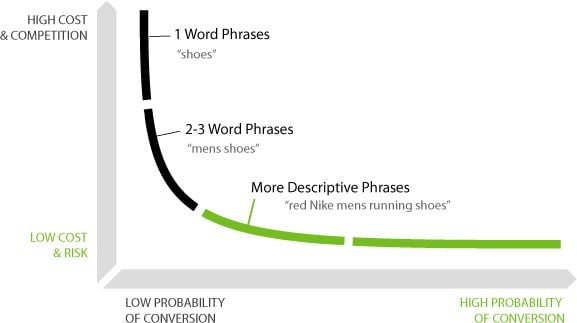
To recap for the consideration phase, focus on long-tail SEO keywords, newsletters, and eBooks.
You could also use blog posts, infographics, case studies, or even videos.
With those, you can guide people through the consideration phase rather than leaving them to their own devices.
In the end, you want to create content that builds trust and builds the prospect’s relationship with your business without being too salesy.
At least, that’s your approach until those people reach the decision stage of the buying process.
Decision Stage for Content Marketing
This is your favorite part of the buying process, because it’s when people take that extra step and purchase.
The decision phase is the point in the buyer’s journey where they’ve made a decision to buy your product or service.
You already have their trust, and they are familiar with your products and what you stand for.
Now, it’s the time to make or break, push or shove, buy or ditch.
The person is either going to become a paying customer or fall into eternal obscurity.
This is the place where your opportunity pipeline, average size of orders, order frequency, and sales come into play.
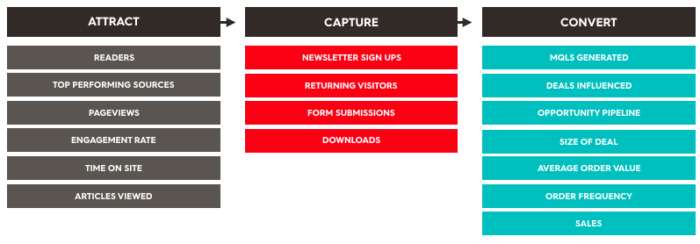
To put it another way, it’s conversion optimization time in terms of your content marketing efforts.
Do you know what that means? It’s time to target long-tail keywords in your content marketing strategy. This is because, in general, the longer the keyword, the more likely someone is to buy from you.
When your prospects are using more specific, longer keywords, they’re at the buying stage, and when you include your brand name in long-tail keywords, that’s even better.
Why? You’ve probably guessed it, but people including brand names in their search want to buy from them,
Just consider this keyword: “how to start an ecommerce store.”
What’s the first result you see?
It’s from Shopify.
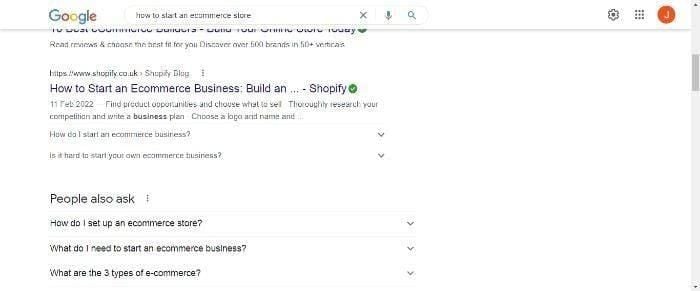
If you know anything about Shopify, then you know it’s an e-commerce platform beginners and experts alike use to build their online stores.
For Shopify, then, they do well to appear for that search.
The people who type in that keyword are most likely ready to take the next step in their buying journey.
You just need to convince them that your business offers the best solution.
Shopify doesn’t let up when they try to convince visitors that they are that best option.
I clicked on that result and glanced through their blog post.
The first thing I noticed is that Shopify has calls to action (CTAs) throughout its content, like these:
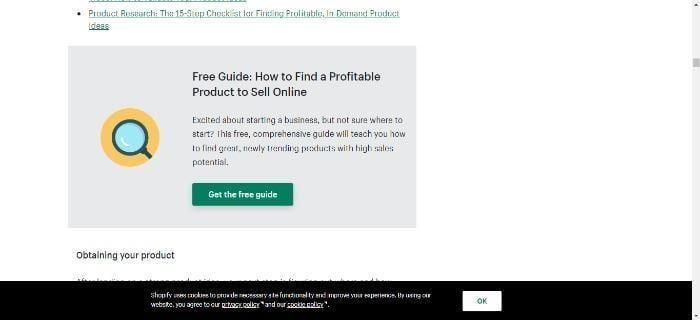
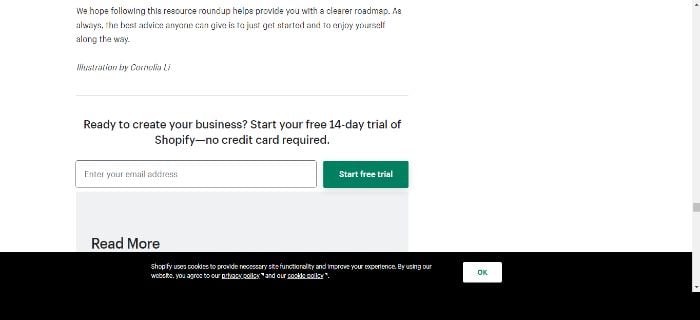
Would these CTAs work for all types of content? Probably not.
In content that caters to people who are simply in the awareness or consideration stages of the buying journey, for instance, those CTAs would probably come off as too pushy.
However, in this content that is supposed to cater to people who are ready to buy, the CTAs are perfect.
You want to strike the same chord that Shopify does.
Use your blog to create content that caters to long-tail, high-commitment keywords and then include compelling CTAs within that content.
Remember: These people are ready to buy. You just have to give them a little push.
Consider offering a discount, free trial, or special offer to do that.
Additional Forms of Content Marketing
Now that you understand what content marketing is, what makes it powerful, and how you can use it to map out your customer’s journey from awareness to conversion, let’s talk about a few additional types of content.
Social Media
Social media is one of the most effective tools for content marketing. It allows you to share your content with a large audience quickly and easily.
In addition, social media provides an opportunity to connect with potential customers and build relationships with them.
It gives free access to a massive number of people within any target market, and if you decide to run advertisements, you can choose where to show your face.
Innocent Drinks is just one example of a company that’s using social media to its advantage.
In particular, it uses social media to strengthen its brand image as a funny and enjoyable business.
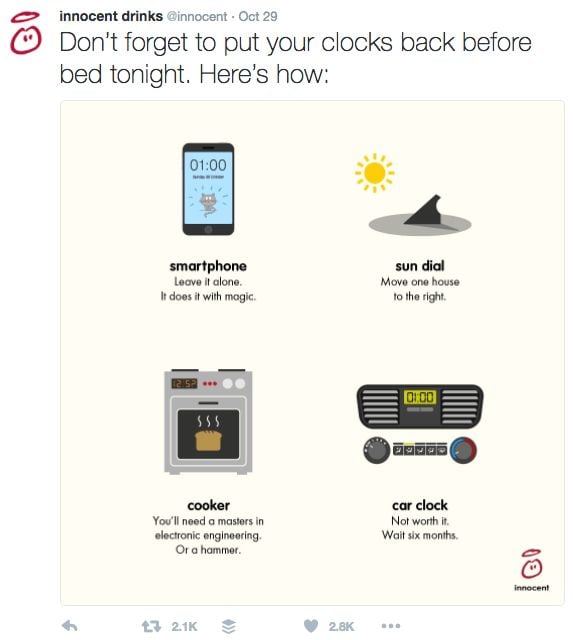
In other words, Innocent entertains its audience before expecting them to buy.
Why? It’s simple. Businesses that build a connection with their customers are more likely to sell to them. And if you can provoke emotion, and make consumers laugh, cry, or share, there’s an even better chance they’re going to buy from you.
Here’s another post from Innocent that surely got a few laughs.

Social media excels at promoting brands because it promotes relationships.
You can grow an organic following, drive traffic, and even encourage sales.
Once you have an audience of your own, then marketing to that audience over and over again becomes easier and cheaper than ever before.
But remember: They follow you because they like your content, not just your products.
So spend a little time entertaining them, and they’ll pay you back in cold, hard cash.
Live Video for Content Marketing
You don’t have to limit yourself to the written word when executing a content marketing strategy. Video can be an incredibly effective medium, too.
According to Wyzowl’s State of Video Marketing Survey:
- 91 percent of marketers surveyed use video as a marketing tool.
- 96 percent say video improves customers’ understanding of its products/services
- 87 percent of marketers feel that video marketing has a positive impact on sales
- 96 percent of marketers consider video an important part of their marketing strategy
Today, with the ability to seamlessly edit videos using solutions like InVideo, the chance of succeeding with your video marketing is now easier than ever before. If that doesn’t convince you, nothing will.
However, there’s one thing more powerful than video: live video.
Grandview Research predicts that by 2030, the video streaming market size will reach $330.51 billion, and people just love to tune in.
According to HubSpot, 57 percent of the consumers surveyed watch live videos three times a week, and their favorite platforms to view them? Yes, you probably guessed it, social media, with YouTube, Facebook, and Instagram being the favorites.
Why this big love for live streaming?
Most likely, it’s transparency. They might make a mistake, they can’t edit the video, and the viewer gets to see who the person really is. In other words, it’s authentic, and that’s what today’s consumers crave.
To round off this section, here’s a quick tip: If you want to build a strong relationship with your audience, then consider running weekly live videos; do them at the same time every week so that people know when to hop on social media and tune in.
Paid Advertising and Content Marketing
Content marketing is primarily an inbound marketing tactic. But that doesn’t mean you have to rely on organic traffic completely. Combining content marketing with paid ads is a great way to increase your reach and drive more conversions.
Consider this ad from Grant Cardone, for instance, with which he markets his business certifications and classes.
Basically, it’s a glorified piece of content that costs money.
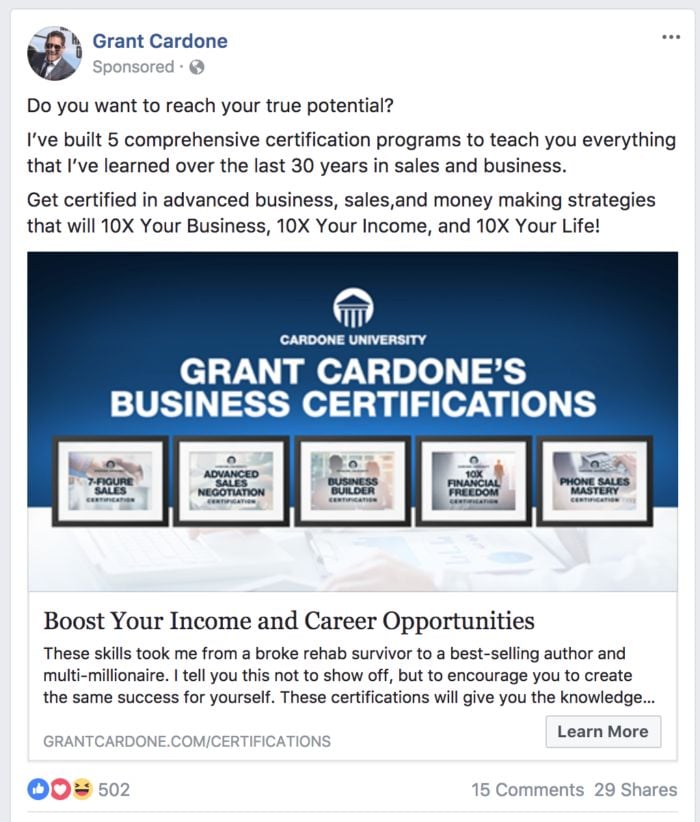
It’s inbound content meeting outbound marketing.
And it’s a great way to attract people to your website.
Now, you might be wondering why you would do something like that (especially if you’re giving away the content for free).
Why would you pay to drive people to your website who aren’t going to pay you in return?
Well, the answer is quite simple.
If your new business has a small audience, then you might need to give your audience growth a boost by running advertisements for some of your more remarkable content.
If you don’t want to wait to grow an audience organically, then you can drive traffic to your content with paid advertisements.
Here’s an example of Shopify doing that.
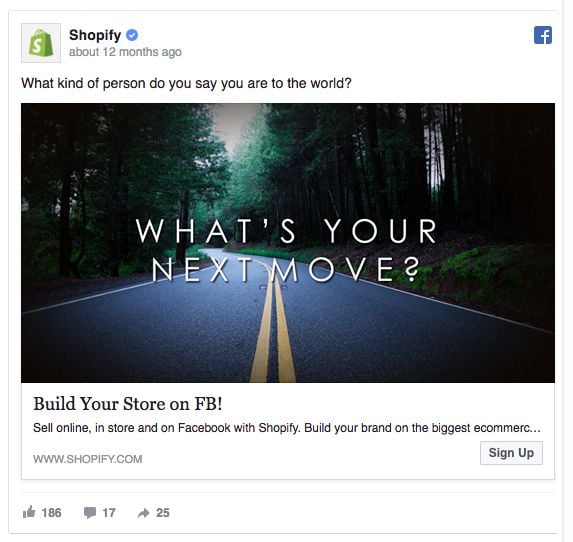
Of course, Facebook isn’t the only place you can use that content marketing strategy.
You can do the same thing with Google Ads.
Just consider this advertisement that drives traffic to an actual piece of helpful content rather than a landing page.
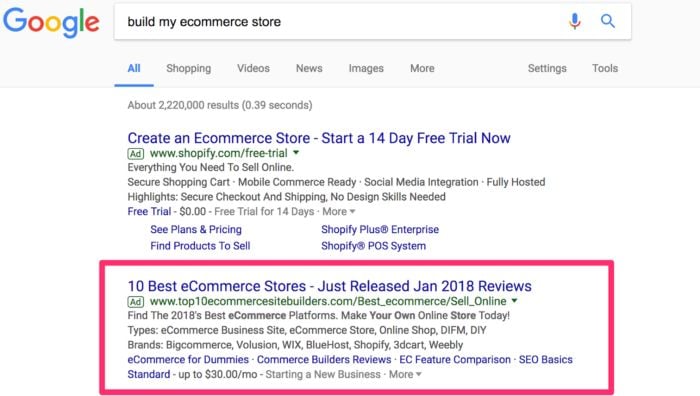
Paid advertisements are a great way to boost your traffic and sales if you’re in the beginning days of your business.
The first days are often the hardest. But with paid advertising, they don’t have to be.
More Content Marketing Tips and Tricks
Let’s end this article by discussing a dozen or so of my favorite content marketing tips and tricks.
Use Analytics
The first tip I have for you is to always pay attention to your analytics; they tell you what’s working and what isn’t, so you can tweak your strategy and optimize results.
If you don’t know how your current content is performing, then you won’t be able to prevent blunders and iterate what’s working well.
Google Analytics will give you all of the necessary information.
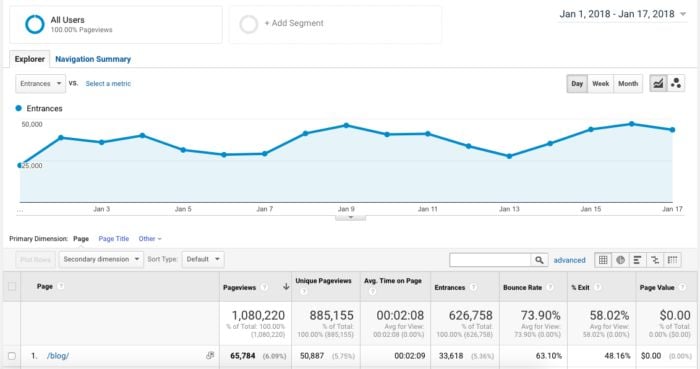
For an even better understanding of your stats and new features, learn about Google’s new standard, Google Analytics 4. On July 1, 2023, Universal Analytics is sunsetting, and GA4 will be the only game in town.
Some features of GA4 include:
- It records website and app data for a clearer picture of the customer journey.
- It comes with privacy controls, including cookieless measurement.
- It integrates with media platforms.
- It includes predictive capabilities.
Use A/B Testing
Once you know how all of your content is performing, run tests. A/B testing is a way to test two pieces of content that are identical except for one factor. Maybe it’s the copy. Maybe it’s the CTA. Maybe it’s the title.
Whatever the case, A/B testing removes all factors except for what you want to examine, giving your test far more accurate results. It’s also a great way to gather the information you need to iterate your current content marketing strategy.
A/B testing is particularly powerful at increasing the conversion rate of your copy. A study by AdPushUp showed conversion rates typically range from 1 to 3 percent. A/B split testing helps you drive that rate up, and even a single additional percentage point in your conversion rate can be significant.
Whether you’re on a team of B2B marketers or you’re a small business owner, running A/B split tests is crucial to know for certain which headlines, calls-to-action, and types of content work best for your readers. Once you know what strategies work, your work becomes much more effective and your overall content marketing strategy much clearer.
A/B split testing can send more targeted buyers to your product pages, as well. For example, Lyyti.com, an online event management software company, ran a split test on its product pages. They set up a product page variation and tested it against the control.
At the end of the testing, the variation page performed better. It clearly showed the features offered in each plan, while the original design wasn’t quite clear enough. Implementing the results of this test increased visits to their “Free Trial” sign-up page by 93.71 percent.
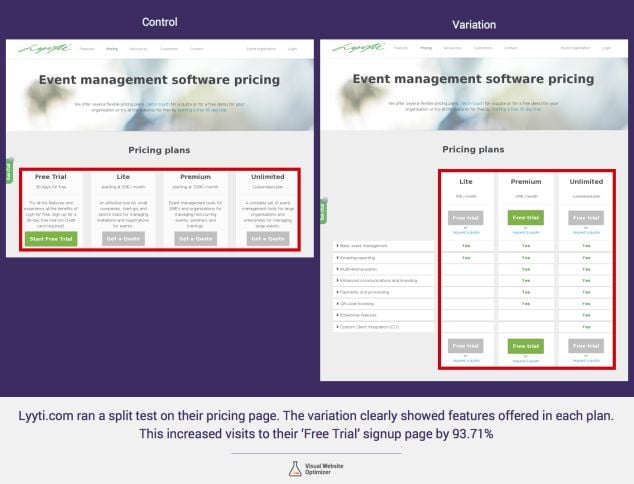
Organize Your Content Schedule
An editorial calendar helps make your content marketing strategy less stressful and more rewarding. Unfortunately, most people never take the time to craft a plan for creating content, marketing it, and tracking its effectiveness.
The importance of an editorial calendar can’t be overemphasized. You need to develop yours as quickly as possible and use software to guide your process:

The three steps you need to take to make your editorial calendar effective are:
- Know your audience and the content type they’re interested in.
- Research your topic thoroughly.
- Create content and measure its effectiveness.
Remember to keep a steady flow of content going out. That’s the way to generate more leads and indexed pages and improve organic traffic.
Build More Targeted Landing Pages
My search traffic almost tripled when I created advanced guides for SEO and several other internet marketing topics. Each of those advanced guides has a separate landing page, optimized for the applicable keywords.
Mailshake, a comprehensive email outreach platform, had success with this, repackaging its cold email masterclass into an eight-part email series. This allowed them to create targeted landing pages and offer user-specific content that matched their place in the customer journey.
In under a year, Mailshake acquired 5,321 email opt-ins for its masterclass.
Or, take a look at Copyblogger Media. Copyblogger has dozens of landing pages, each aimed at a keyword that the target audience is passionate about. That’s a lesson for you when developing a sound content marketing strategy: When creating more landing pages, think strategically about keywords and build your content around the right ones.
The easiest way to start creating high-quality landing pages is to use templates.
There are plenty to choose from, but I like Unbounce and Instapage. Both are paid platforms, but they’re a great way to create effective landing pages quickly.
Segment Your Audience to Build Engagement
Smart content marketers know they need to segment their audiences based on product need. Segmentation is crucial for one simple reason: Some of your blog readers aren’t buyers, but others are.
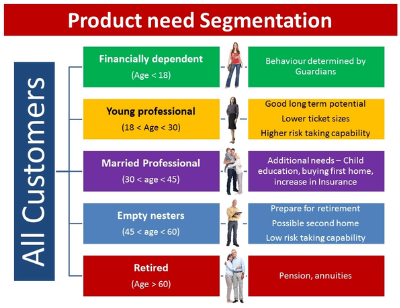
Simply put, your content can’t suit everyone because people are at different phases of the buying cycle. For example, content designed to create awareness with new customers is wasted on loyal repeat customers.
Make the most of your marketing efforts by segmenting customers based on their personas. Remember, a buyer persona is a fully fleshed-out profile of one segment of your audience. It enables you to develop content that speaks to each segment more effectively.
Here’s an example of one in action:

Segmenting your target audience is difficult on your blog or website (though not impossible with content personalization), but email segmentation is pretty simple.
Email list segmentation is a must if you want to get the most from your list. According to Campaign Monitor, marketers who used segmented campaigns saw a 760 percent increase in revenue. Not too bad!
Check out my article “10 Quick and Easy Email Marketing Segmentation Strategies to Try Today” to find out how email segmentation can boost your content marketing.
Implement Adaptive Content
Millennials and Gen Z now make up a huge segment of the U.S. population.
There’s a good chance these groups make up a large chunk of your target audience. If so, your content should speak to their needs and values.
Both of these groups grew up with technology as a big part of their lives, so they have high expectations for how businesses use technology. They also value experience above almost anything else, and this plays right into what content marketing is all about.
While both groups have similarities, you need to target each of them in a slightly different way. Find out more about how to market to Millennials, and target Gen Z.
Adaptive content is one way to go. Adaptive content is simply the content that supports meaningful interactions across different platforms. Think of it like water—whatever you pour it into, it takes the shape of that container.
For example, you might use their name at the top of a booking site or suggest content based on their past interactions with your brand.
Your readers should be able to access your content on a desktop computer, then continue where they left off using their smartphone or complete their purchases through your mobile app, with absolutely no hassles at all.
Consider the Hedgehog Model
A hedgehog is a small mammal with stiff spines and a small, pointed snout. What does a small mammal have to do with content creation and your marketing strategy? (There’s a point, I promise!)
The hedgehog concept is based on an old parable about a hedgehog and a fox. The fox knows lots of things—he’s constantly trying new ways to beat the hedgehog. The hedgehog, however, stays focused on one big idea.
What does this mean for your content strategy?
It simply means you should start where you are and stay focused. Why worry about the fact your blog isn’t generating 1,000 monthly visits yet? Instead, create content consistently and use a content marketing strategy to reach your goals.
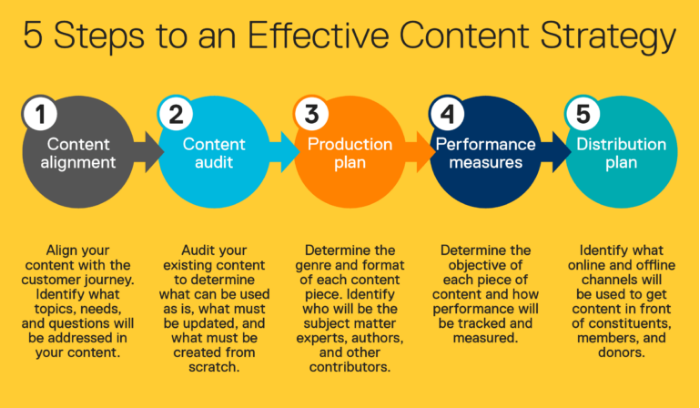
Instead of obsessing over reaching 1,000 monthly visitors, for example, focus on 100 each month. Just make sure that your goal is realistic and measurable.
If you’re able to hit that smaller goal, the hedgehog model says to treat them well and deliver great content they’ll share with their friends across their social media channels.
Apply the same technique to your email list. Focus on getting three to five subscribers every single day, instead of your first 100 subscribers. By the end of the month, you’ll have 90 to 150 email subscribers.
Invest In Topic Training Modules
Thanks to online learning platforms like Udemy and LinkedIn Learning, you can become a subject matter expert in a matter of hours. There’s no longer any need to waste tons of time researching your topic because someone with better training, resources, and time has done all that for you.
So, let’s say you want to create an in-depth article about link building. Here’s how to research your topic using Udemy:
- Step #1: Go to Udemy.com. Type your main keyword (e.g., link building SEO) into the search box. Hit the enter button on your keyboard.
- Step #2: Analyze the courses. From the top results, choose one that suits your keyword, then click on it to see the modules.
- Step #3: Extract ideas from the module. You can find the module for that particular topic when you scroll down.
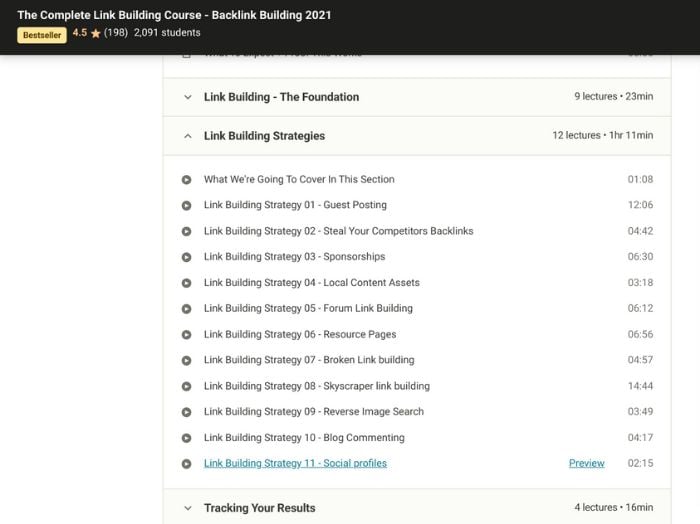
Note: Most courses at Udemy will typically cost you between $15 and $199, although there are free courses available. If you have the budget for it, you can buy the course. Here, however, we’re just looking for ideas to organize your blog post from module titles, so there’s no need to sign up for the course itself.
From the highlighted module above, I can create five unique and high-converting headlines for my next blog post.
- 11 Traffic-Generating Links and Where To Get Them
- How to Use Broken Link Building to Create Links Google Will Love
- Traffic-Generating Links: Where to Get Them and Improve Search Traffic
- How to Get Traffic-Generating Links with Help from Your Competitors
- The Best Way to Develop a Traffic-Generating Link Building Strategy
Spending just 10 to 20 minutes each week studying Udemy course modules will give you lots of ideas to write about and expand your analytical skills and give you a more thorough understanding of your industry and your target audience.
Overall, it’ll enhance your content marketing strategy and inform your content creation.
Just remember, the goal is inspiration. Don’t copy other people’s work.
Conduct a Competitive Analysis
Competitor analysis isn’t optional these days. You need to spy on your competitors to know exactly what they’re doing and find ways to outsmart them.
When its results are integrated into your strategy, competitor analysis can improve many aspects of your marketing, including your conversion rate.
The easiest way to know what your competitors are doing, in terms of where they’re getting backlinks and how many quality links they have, is to use the right automated tools.
First and foremost, you’ll want to find out who your strongest competitors are. You can use Google to search for your main keyword (e.g., beginners guide to blogging), then check which sites are competing with you.
Another way to perform competitor analysis is with Ubersuggest. Select competitive analysis from the left sidebar and then enter your domain.

You will then see a list of websites that compete for similar keywords. You can dig deeper into each competitor to find out which specific keywords you are competing for by clicking “view all.”

This provides an immediate picture of whom you are competing with and what keywords you should target.
Inject Emotion Into Headlines
The best way to create magnetic headlines is to target emotional keywords. Doing so will supercharge your content. People will not only read it; they’ll be inspired to share it on social media and beyond as well.
For example, if you were trying to lose weight, you’d probably go to Google and search for keywords like the following:
- Lose 10 pounds quickly
- Fastest way to burn extra fat
- Drop 20 pounds in 2 weeks
Here are more variations to the three search terms above:
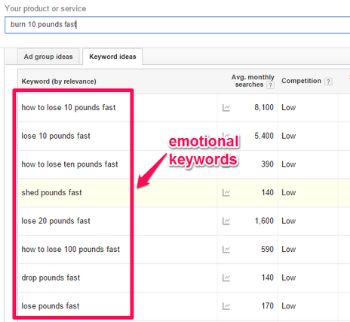
In our example, if you found an article or video targeting any of the keywords above, you’d respond positively. That’s because those keywords mirror what you deeply desire.
The same is true for your target audience. When they’re searching for keywords, and you notice a hint of immediacy, you know that those keywords will convert into clicks, visits, and sales when you eventually rank in Google.
Let’s assume you help companies and digital businesses to grow revenue. Here are some of the keywords you can use to create powerful headlines to grow your search traffic and rankings:
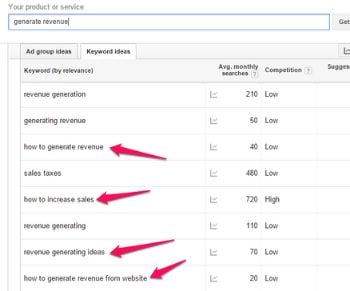
From the screenshot above, you can see the “emotional keywords.” I call them “emotional” because searchers are already pre-sold on the idea of increasing revenue. They’re just waiting for a nudge to take action.
To make your headlines high-converting, include numbers—especially odd numbers because some studies show odd numbers outperform even numbers.
Let’s craft some headlines based on those emotional keywords:
- 7 Powerful Revenue Generating Ideas You Can Use Today
- 9 Revenue Generating Ideas to Help Your Business Soar
- 6 Steps to Increase Your Sales Right Now
- How to Increase Sales in Your Small Business
Better yet, you could turn the emotional keywords into data-driven headlines to share your experiments and results:
- How To Increase Sales: An Experiment On How I Generated $25,000
- Case Study: How To Increase Sales as an Ecommerce Beginner
- 13 Revenue Generating Ideas That Yielded $10,837 Sales and 2,636 Email Subscribers
Build Engagement Onto Your Own Space
Social media is one of the best ways to reach your audience today. If you’re not marketing yourself on social media, you could be missing out on a huge portion of your audience.
It’s not just about building out your profiles and engaging people through the platform, though; it’s also about what action you want followers to take. One of your goals with social media should always be to bring people to your own space.
You have more control over your blog and email list than any social media profile or platform. No matter how successful you are on social, you don’t own that connection. Make sure you’re not abandoning your blog audience for social followers.
Grow your social media presence, but make sure you’re using it to bring people to a medium you control. From here, you can control the customer journey, build your email list and nurture your subscribers.
Repurpose Your Own Content to Get the Most Mileage Out of It
Blogging can help you reach more of your target audience, particularly if your blogs are frequently shared across social media channels. How do you get more referral traffic from your content, though?
You’ve got to think outside the box. Inbound marketing works, but you’ve got to diversify your efforts if you want to get outstanding results. The majority of your target audience hasn’t visited your blog yet. They are, however, on Slideshare, YouTube, and other content platforms.
You’ve got to be everywhere they are. Your content should make a mark online. If you’ve spent your precious time creating great content, don’t let it sit there in oblivion.
It’s time to embrace content repurposing.
This content marketing tactic helps you make the most of your content by using it in different formats.
For example, you could take an article, convert it into a PDF report, and offer it as an eBook. You could also create PowerPoint presentations and upload them to Slideshare or create an infographic out of a case study.
Be very careful to repurpose only your high-quality content that produced measurable results the first time around. Not every piece of content will work for this purpose.
Encourage User-Generated Content
For some businesses, user-generated content is their content marketing bread and butter.
When companies encourage customers to create content for their brands, it’s a double win: The company saves time and money, and they distribute compelling content.
GoPro does a good job of encouraging and posting user-generated content. Consider this video made by an avid “GoProer.” Start watching at 1:28 and cringe a few seconds after as you see what happens.
This video has over 13 million views, and it generated a ton of brand awareness for GoPro. All of that was at no cost to the business. Since the user created the content, the business simply stood by and watched while their product was marketed for them.
Hijack Trending Topics (When It Makes Sense)
There is always something trending online, and you can use trending topics to your marketing advantage.
How?
By creating content that plays off them.
Hootsuite made the video “Game of Social Thrones.” That’s right, a social media tool used “Game of Thrones.”
How did they do this? It got creative and found a way to connect the trending topic to its brand.
While “Game of Thrones” was popular, it wasn’t always the talk of the town. Other topics often are at the forefront of consumers’ minds so how do you figure out what topics to talk about?
It’s easy.
Go to Google Trends.
Glance through the topics on the home page. These are topics that are currently getting a lot of search traffic on Google.
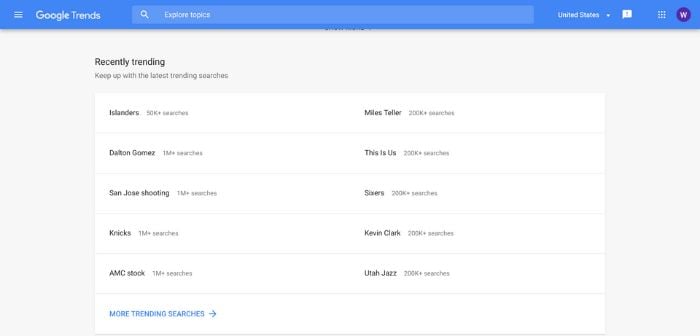
Use Google Trends to find trending topics to hijack with your content marketing strategy. Doing so can give your content the same appeal as the trending topic.
It’s always important to remember your brand image, though. There are certain topics you don’t want associated with your brand, so make sure you’re hijacking the right trends.
FAQs
Content marketing is a marketing strategy that focuses on creating content of any kind to drive more traffic and conversions from targeted audiences by answering their questions and addressing their pain points.
To most people, content marketing means creating blog posts, eBooks, and other forms of online writing to build awareness and drive sales. But content marketing comes in many different forms and can also mean social media posts, images, videos, and infographics.
Examples of content marketing can include your blog, a branded YouTube channel, an ebook, or even an email newsIetter. The Neil Patel blog in and of itself is an example of content marketing. I use it to boost awareness of my digital marketing agency and my online marketing tool, Ubersuggest. A branded YouTube channel is another example of content marketing. So is a newsletter like Morning Brew.
There are dozens of types of content marketing. Some of the most popular forms of content marketing include eBooks, blog posts, articles, white papers, social media, paid ads, billboards, and so much more.
There are four main stages of the content marketing purchasing funnel as I have described above. They are: awareness, consideration, conversion, and loyalty.
Conclusion
Phew! That was a lot of tips.
Hopefully, this article gives you a good idea of what content marketing is and what it takes to be a good content marketer.
What’s more, I really hope that you see that it doesn’t take a huge marketing budget. The world gets noisier each day, and one way to stand out is through creative content marketing that gets people talking, and sharing.
Those who focus their energy on telling good stories, no matter the platform or context, are the real winners in today’s marketing world.
If you have any other great examples I’ve missed, please tell me about them in the comments.
